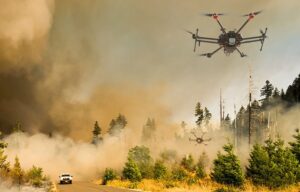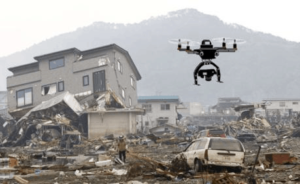Drones, or unmanned aerial vehicles (UAVs), have emerged as a vital tool in disaster relief and response efforts. They provide a unique perspective and are able to access areas that are inaccessible to traditional methods of disaster response. In recent years, drones have been used in a variety of disaster situations, including hurricanes, earthquakes, floods, and wildfires. In this article, we will explore the role of drones in disaster relief and response and their benefits.
Role of Drones in Disaster Relief and Response
The use of drones in disaster relief and response is becoming increasingly popular due to their ability to provide real-time situational awareness. Drones can fly over affected areas and capture high-resolution images and videos, which can be used to assess the extent of damage caused by the disaster. This information can be used by emergency responders to develop a plan of action and prioritize response efforts. Drones can also provide real-time updates on changing conditions, such as shifting flood waters or fire hotspots, allowing for more effective response efforts.

Drones have been particularly useful in search and rescue operations. In the aftermath of a disaster, it can be challenging to locate survivors, especially in areas that are difficult to access. Drones equipped with thermal cameras and other sensors can detect heat signatures, which can help rescuers locate survivors. Drones can also be used to drop essential supplies to stranded individuals in remote locations.
Another important role of drones in disaster relief and response is damage assessment. Drones can quickly and accurately assess the damage caused by a disaster, which can help emergency responders determine the appropriate resources needed for recovery efforts. The data collected by drones can also be used to create 3D models of damaged buildings and infrastructure, which can help with reconstruction efforts.
In addition to their ability to provide situational awareness and aid in search and rescue operations, drones can also help with communication and coordination efforts during a disaster. Drones equipped with communication equipment can act as mobile cell towers, providing temporary internet and phone service to affected areas. This can be crucial in areas where communication infrastructure has been damaged or destroyed. Drones can also be used to deliver critical supplies, such as medicine and food, to affected areas.
The benefits of using drones in disaster relief and response are numerous. One of the biggest advantages is their ability to quickly and efficiently gather data. Traditional methods of damage assessment, such as sending in teams of surveyors, can be time-consuming and dangerous, especially in areas that are still unstable. Drones can provide detailed data in a fraction of the time, which can help emergency responders make more informed decisions about response efforts.
Drones are also much more cost-effective than traditional methods of disaster response. Traditional methods of damage assessment and search and rescue operations require a large number of personnel and resources, which can be expensive. Drones, on the other hand, require only a few trained operators and can be launched quickly and easily, making them a more cost-effective solution.
One of the biggest benefits of using drones in disaster relief and response is their ability to access areas that are difficult or dangerous for humans to reach. Drones can fly over flooded areas, volcanic eruptions, and other hazardous areas, providing valuable information without putting people at risk. This can help emergency responders make more informed decisions about response efforts while keeping their personnel safe.
Despite their many benefits, there are also some challenges associated with using drones in disaster relief and response. One of the biggest challenges is regulatory. In many countries, drones are heavily regulated, and obtaining the necessary permits and licenses can be time-consuming and expensive. There are also concerns about privacy and data security when using drones in disaster response efforts.
Another challenge is the limited flight time of drones. Most drones have a flight time of around 30 minutes, which can be a limitation in disaster response efforts that require longer flights. However, advances in battery technology and drone design are addressing this challenge, with some drones now able to fly for several hours at a time.
In addition to regulatory and flight time challenges, there are also concerns about the reliability and durability of drones in harsh environments. Drones can be affected by high winds, extreme temperatures, and precipitation, which can impact their ability to fly and collect data. Ensuring that drones are designed and tested to withstand these conditions is crucial to their effectiveness in disaster relief and response efforts.

Despite these challenges, the benefits of using drones in disaster relief and response far outweigh the challenges. Drones provide a unique perspective and are able to access areas that are inaccessible to traditional methods of disaster response. They can provide real-time situational awareness, aid in search and rescue operations, assist with damage assessment, and provide communication and coordination support. Drones are also cost-effective, quick, and efficient, making them a valuable tool in disaster relief and response efforts.
As drone technology continues to advance, their capabilities in disaster relief and response will only improve. Advances in sensor technology, battery life, and durability will allow drones to fly longer, collect more detailed data, and operate in more challenging environments. Additionally, advancements in artificial intelligence (AI) and machine learning (ML) are allowing drones to analyze data in real-time, providing emergency responders with actionable insights and improving response efforts.
To fully realize the potential of drones in disaster relief and response, it is crucial that governments and emergency response organizations invest in drone technology and training. This includes developing regulatory frameworks that support the use of drones in disaster response, as well as training emergency responders to operate drones safely and effectively.
Conclusion
In conclusion, drones have emerged as a vital tool in disaster relief and response efforts. Their ability to provide real-time situational awareness, aid in search and rescue operations, assist with damage assessment, and provide communication and coordination support make them an invaluable asset in disaster response efforts. While there are challenges associated with using drones in disaster relief and response, the benefits far outweigh the challenges. As drone technology continues to advance, their capabilities in disaster relief and response will only improve, making them an even more valuable tool in future disaster response efforts.










